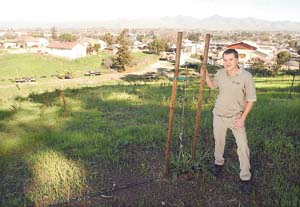
Neighborhood dinners and decisions made by consensus are some of
the aspects of cohousing
– a Danish concept imported to the United States 20 years ago –
that residents of Temescal Creek in north Oakland say helps them
forge bonds with their neighbors that are much stronger than those
in a typical neighborhood.
Hollister – Neighborhood dinners and decisions made by consensus are some of the aspects of cohousing – a Danish concept imported to the United States 20 years ago – that residents of Temescal Creek in north Oakland say helps them forge bonds with their neighbors that are much stronger than those in a typical neighborhood.
That is the lifestyle that local developer Tod duBois hopes to bring to Hollister with a cohousing development on Vista Park Hill. To that end, he has held two forums in a search to find like-minded residents who will design and build their ideal cohousing community right here in Hollister.
Cohousing – a different way of building a community that gives future residents the chance to help design and run their neighborhood – has been steadily catching on in the United States since it was imported from Denmark nearly two decades ago, according to Zev Paiss, a principal in Colorado-based Abraham Paiss & Associates, which assists groups as they develop their cohousing communities.
“The biggest difference (with cohousing) is people come together before the homes are built,” Paiss said. “They come together because they want to know their neighbors.”
While his plan plans are preliminary, duBois wants to build a cohousing community, consisting of 15 to 30 condominiums, on nearly three acres bordering the northeast corner of Hollister’s panoramic Vista Park Hill. Homes in the development may range in price from $250,000 to $500,000.
Though only 10 people came to a cohousing orientation that duBois held late last month, duBois said that he will still work to see cohousing become a reality in Hollister. Of those who attended the orientation, four people had a strong interest in the idea and made the commitment to attend monthly planning meetings, he said.
“The bottom line, I was pretty happy,” he said.
Cohousing was introduced to the U.S. by a 1988 book written by Kathryn McCamant and Chuck Durrett, architects who spent a year studying the living arrangement in Denmark. The nation’s first cohousing development, Muir Commons in Davis, was completed in 1991, according to Paiss. Since then, 85 cohousing communities have been built in the U.S. – with 20 in California – and about two dozen are under construction, he said.
While living in a cohousing community requires more work than living in a standard subdivision – in such a neighborhood many decisions are made by consensus and residents are required to pitch in with landscaping and other duties – those who have chosen to take up residence in a cohousing development say the rewards of a tight-knit community are worth the work.
“It’s not for everybody,” said Karen Hester, a founder of Temescal Creek. “But for people who really want to experience community life, it’s the way to go.”
Founded in 1999, Temescal Creek has nine units, including single-family dwellings and duplexes, a common house and 22 residents. Home owners pay a “condo fee,” which is used to pay for things like insurance and water and trash, Hester said. Residents also participate in neighborhood meetings, committees and preparation of the common meals that neighbors share a couple of times a week.
Hester said that living in cohousing is a good way to develop deep relationships with neighbors.
“It’s mostly great,” she said. “A lot of people are not living in the same town as their biological families, we are all looking for community.”
Hester did say, however, that things are not always easy.
“It’s not all wonderful,” she said. “There are definitely times when you want to tear your hair out working with different people trying to make a decision.”
Paiss, who lives in the Nomad Cohousing Community in Boulder, Colo., said that teaching people to make decisions by consensus is one of the biggest challenges in cohousing.
“Most people are not used to making decisions with other people,” he said. “It’s not natural in our culture.”
One of Abraham Paiss & Associates’ services is to hold workshops with fledgling cohousing groups and teach members the skills to work together when making decisions about the development.
“Once people get the gist of it, it makes a lot more sense and they really get a hang of it,” he said.
While having such a close connection to neighbors can be trying at times, Paiss said the tight community fostered by cohousing creates a more secure environment where neighbors look out for one another.
“It can make your life simpler because you have friends close by,” he said.
duBois will hold another cohousing orientation on Feb. 18 at 10am in Veterans Memorial Building. The orientation will be followed by a business meeting. Both events are open to the public.
Luke Roney covers local government and the environment for the Free Lance. Reach him at 831-637-5566 ext. 335 or at lr****@***********ws.com.









